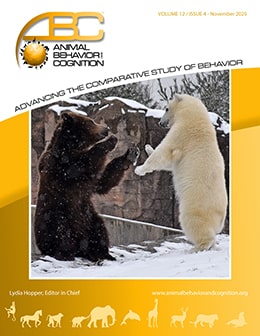Vol 12, Issue 4, November 2025
Engineers and Architects: Shelter Construction by Male Visayan Warty Pigs (Sus cebifrons negrinus) in Negros Island, Philippines
Citation
Ward, M., Tan, E. L., Montano-Ward, Y., McPherson, G., Magbanua, J., Redeña-Santos, J. C., & de Guia, A. P. O. (2025). Engineers and architects: Shelter construction by male Visayan warty pigs (Sus cebifrons negrinus) in Negros Island, Philippine. Animal Behavior and Cognition, 12(4), 576-582. https://doi.org/10.26451/abc.12.04.06.2025
Abstract
Shelter construction has been observed in many fauna but is most common in birds, mammals and insects. Whilst nest construction for birthing and rearing young has been observed in the Eurasian wild boar (Sus scrofa) and captive Visayan warty pigs (Sus cebifrons negrinus), non-nest structures are unheard of in suids until now. The Visayan warty pig is a critically endangered species that is currently restricted to two islands in the West Visayan faunal region of the Philippines. Furthermore, in situ ecological research on this species is severely limited, hampering conservation efforts as it is threatened with habitat loss and population decline. Here, we describe the novel discovery of a warty pig made structure with the potential function of providing thermoregulatory assistance and avoiding heavy rain. This structure appears to be constructed by male individuals in the Visayan warty pig, for assumed weather avoidance and environmental regulation, and whilst there is no conclusive proof of the species architectural ingenuity or structure use, we also highlight identical structures made and used in the same way by the sister species the Mindoro warty pig (Sus oliveri) from a separate corroborating observation. The Visayan warty pig was the first wild pig species to be recorded using tools, it is known for its complex social structures and high levels of intelligence, but now it has elevated its intellectual potential as the first pig species to create artificial structures for shelter.
Keywords
Warty pig, Construction, Ecology, Translocated, Research, Philippines, Architecture
